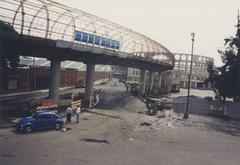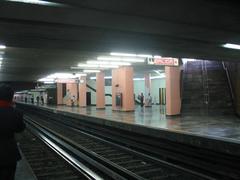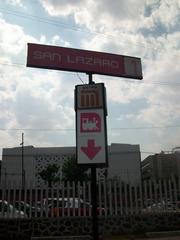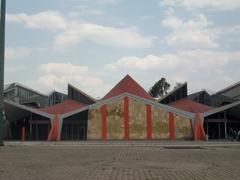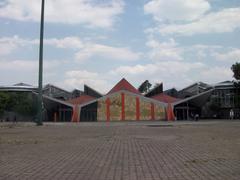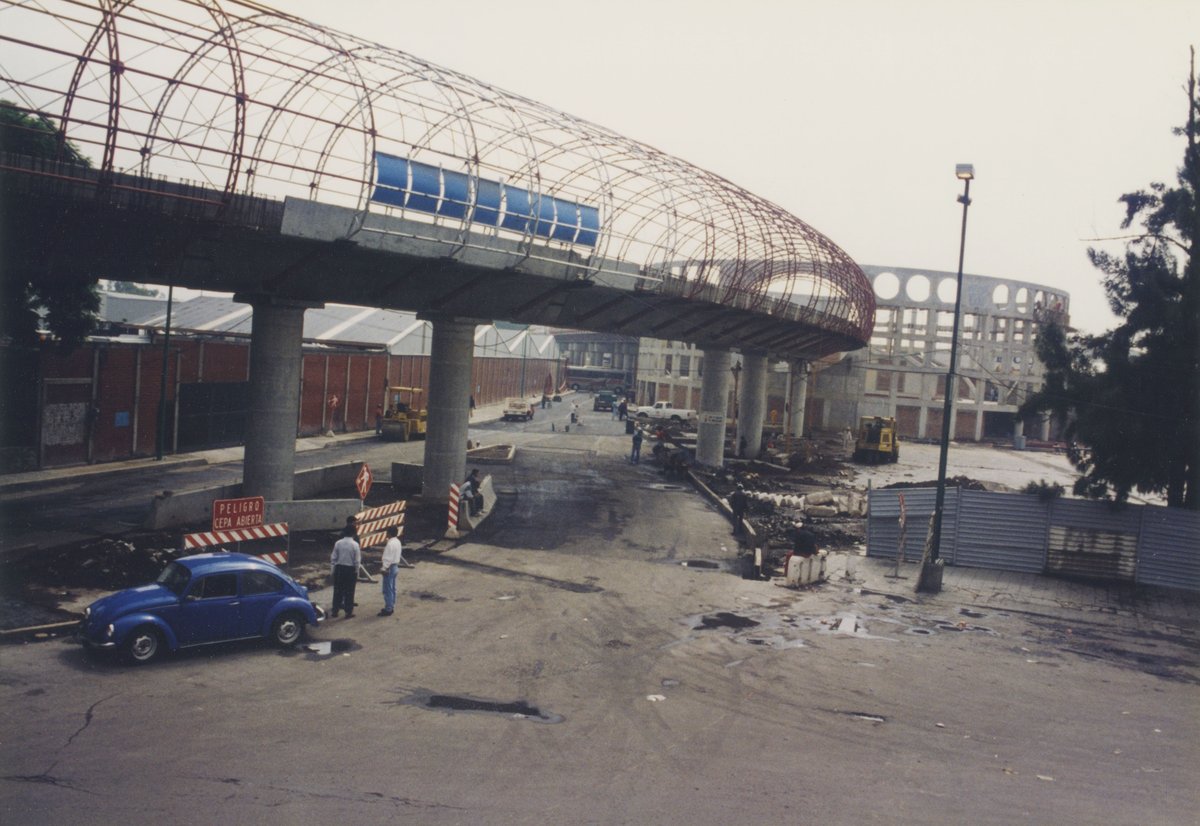
San Lázaro Mexico City: Visiting Hours, Tickets, and Historical Sites Guide
Date: 14/06/2025
Introduction to San Lázaro, Mexico City: History and Cultural Significance
San Lázaro is a historically significant district in the eastern part of Mexico City. Renowned for its blend of colonial heritage, political importance, and vibrant urban culture, the area is best known as the location of the Palacio Legislativo de San Lázaro, seat of Mexico’s Chamber of Deputies. This district reflects Mexico’s evolving identity, transitioning from a colonial customs checkpoint in the 17th century to a modern center of governance and civic life.
Key landmarks include the Antigua Garita de San Lázaro, a rare surviving colonial military structure from 1632, and the modern Legislative Palace completed in 1981. The district also functions as a major transportation hub, anchored by the San Lázaro Metro station (Lines 1 and B) and the TAPO bus terminal, making it highly accessible (mexicocity.cdmx.gob.mx; everything.explained.today). San Lázaro offers visitors a rich tapestry of experiences, from exploring markets like La Merced and Mercado de Sonora to visiting museums and community centers (mexicocity.cdmx.gob.mx; programadestinosmexico.com).
Table of Contents
- Introduction to San Lázaro
- Colonial Origins and Development
- 19th & 20th Century Transformations
- The San Lázaro Railway Terminal and Urban Connectivity
- Political and Legislative Significance
- Architectural and Cultural Heritage
- Visiting San Lázaro: Hours, Tickets, and Practical Information
- Nearby Attractions
- Legislative Palace of San Lázaro: History, Architecture, and Museum
- Practical Visitor Tips
- Special Events and Weather Guide
- Accommodation Options
- Frequently Asked Questions (FAQs)
- Conclusion and Recommendations
- References
Colonial Origins and Early Development
San Lázaro’s roots stretch back to the early 17th century, when Spanish colonial authorities established sentry posts—or garitas—to control entry, levy taxes, and regulate commerce. The Antigua Garita de San Lázaro, built in 1632, was a key checkpoint on the city’s eastern approach, supporting administrative and commercial functions critical to colonial Mexico City (mexicocity.cdmx.gob.mx). Though its original role ended in 1647, its presence marked San Lázaro as a vital node for movement and trade, and its structure survived as the city evolved.
Transformation Through the 19th and 20th Centuries
In the 19th century, the garita was expanded (1820) and later repurposed several times, reflecting the district’s adaptability. By 1896, it became a primary school, and in the 20th century, it served as the headquarters of the Federal Telegraph Directorate before becoming a childcare center for the Legislative Palace. Restoration efforts in the 21st century, including the PILARES Candelaria community center (2019), have helped preserve this historical landmark (mexicocity.cdmx.gob.mx).
The San Lázaro Railway Terminal and Urban Connectivity
The construction of the San Lázaro railway terminal established the area as a major transportation hub, connecting Mexico City with eastern states such as Puebla and Veracruz. With the advent of the Metro system—Metro San Lázaro station opened in 1969 (Line 1) and expanded in 1999 (Line B)—the district became a focal point for urban transit, now also integrating Metrobus lines and the TAPO bus terminal (mexicocity.cdmx.gob.mx). The transit infrastructure, some designed by architect Félix Candela, draws commuters and visitors alike.
Political and Legislative Significance
San Lázaro is synonymous with contemporary Mexican politics due to the Palacio Legislativo de San Lázaro, seat of the Chamber of Deputies. The district’s evolution from colonial gate to center of legislative power mirrors Mexico’s broader transformation. The nearby Federal Legislative Museum further emphasizes the area’s civic and educational value (everything.explained.today).
Architectural and Cultural Heritage
The Antigua Garita de San Lázaro stands as one of the few remaining examples of colonial military architecture, recognized as a protected monument since 1931. The site’s robust, utilitarian design reflects its original defensive function. Other landmarks, such as the abandoned San Jeronimito Chapel and bustling markets like La Merced and Mercado de Sonora, highlight the district’s intersection of tradition and modernity (mexicocity.cdmx.gob.mx).
Visiting San Lázaro: Hours, Tickets, and Practical Information
- Antigua Garita de San Lázaro
- Hours: 9:00 AM–5:00 PM, Tuesday–Sunday (may vary during holidays or special events)
- Admission: Free; some adjacent museums/cultural centers may charge a nominal fee
- Legislative Museum
- Hours: Tuesday–Saturday, 9:00 AM–6:00 PM (mexicocity.cdmx.gob.mx)
- Admission: Free; no tickets required
- Accessibility
- Most sites, including the Legislative Palace and community centers, are accessible for wheelchair users and visitors with disabilities
- Guided Tours
- Available through local operators and the museum; advance booking recommended for English-language tours
- Getting There
- Metro San Lázaro station (Lines 1 & B), TAPO bus terminal, and Metrobus lines provide excellent connectivity
Nearby Attractions
- La Merced Market: Fresh produce, crafts, and street food
- Mercado de Sonora: Traditional medicine, herbs, and folk art
- San Jeronimito Atlixco: Historic site within walking distance
- Parque Toriello: Local green space
- San Fernando Flower Market: Open 24 hours, short taxi ride away
Legislative Palace of San Lázaro: History, Architecture, and Museum
Historical Background and Construction
The Legislative Palace was built to accommodate an expanded Chamber of Deputies after political reforms in 1977. Constructed on the former San Lázaro Railway Station site, it was inaugurated in 1981. Architects Pedro Ramírez Vázquez, Jorge Campuzano, and David Suárez led the design. A fire in 1989 prompted restoration before reopening in 1992 (everything.explained.today; mexicocalidadsuprema.com.mx).
Architectural Features and Symbolism
The building’s façade, featuring red tezontle stone and white marble, is adorned with a monumental bronze bas-relief by José Chávez Morado, representing Mexican history and identity. Inside, the Salón de Sesiones is among the country’s largest legislative chambers, with a Wall of Honor commemorating national heroes (everything.explained.today).
Legislative Museum
The museum within the palace showcases Mexico’s legislative evolution, with permanent exhibits, historical documents, and murals. The Archive of the Word collects interviews with deputies, providing personal insight into political life (programadestinosmexico.com).
Visiting Hours and Access
- Palace: Monday–Friday, 9:00 AM–3:00 PM (access may be restricted during sessions)
- Museum: Monday–Friday, 10:00 AM–6:00 PM
- Admission: Free; valid government-issued ID required for palace entry; advance booking for guided tours recommended (mexicocalidadsuprema.com.mx)
Accessibility and Visitor Facilities
The palace is equipped with ramps, elevators, accessible restrooms, and visitor services. Dress respectfully, and note that photography may be restricted in certain areas.
Location and Transportation
- Address: Av. Congreso de la Unión No. 66, Colonia El Parque, Venustiano Carranza, Mexico City
- Metro: San Lázaro station (Lines 1 and B)
Practical Visitor Tips
- Safety: San Lázaro is generally safe during the day, but remain vigilant for pickpockets, especially on public transport (thebrokebackpacker.com).
- Transportation: Use Metro and TAPO terminal for city and regional travel; ride-hailing apps like Uber and Didi are recommended for added safety.
- Health: Drink bottled water; use sun protection due to high altitude.
- Language: Spanish is the primary language; some English signage in major sites and museums.
- Money: Carry cash for markets and small purchases; ATMs available in secure locations.
- Dress: Modest attire is recommended for government buildings.
- Photography: Always ask staff before taking photos inside official or sensitive areas.
Special Events and Weather Guide
- Events: The Legislative Museum hosts workshops, forums, and exhibitions. Check the official calendar for upcoming events.
- Best Time to Visit: January–March for pleasant weather; July–September is rainy season with afternoon showers.
- Festivals: The district provides easy access to citywide events, such as Day of the Dead celebrations at the Zócalo.
Accommodation Options
While the immediate area is administrative, nearby districts like Centro Histórico, Roma, and Juárez offer a range of accommodations, from budget hostels to luxury hotels.
Frequently Asked Questions (FAQs)
Q: What are the visiting hours for the Antigua Garita de San Lázaro and the Legislative Museum?
A: Antigua Garita: 9:00 AM–5:00 PM, Tuesday–Sunday. Legislative Museum: Tuesday–Saturday, 9:00 AM–6:00 PM.
Q: Is there an entry fee?
A: No, entry to key sites is free; some museums or tours may require advance booking.
Q: How do I get to San Lázaro?
A: Via Metro San Lázaro station (Lines 1 and B), TAPO bus terminal, or authorized taxis/rideshares.
Q: Are guided tours available?
A: Yes, through the museum and local operators; advance reservation is recommended, especially for English-language tours.
Q: Is the area accessible for visitors with disabilities?
A: Yes, most major sites have ramps, elevators, and accessible restrooms.
Q: Can I take photos inside?
A: Ask for permission before photographing in official buildings.
Conclusion and Recommendations
San Lázaro stands at the crossroads of Mexico City’s history, politics, and urban life. From the colonial Antigua Garita to the modern Legislative Palace, the district encapsulates the country’s journey from colonial control to democratic governance. With free and accessible entry to major sites, rich cultural attractions, and excellent transit connections, San Lázaro is a rewarding destination for travelers interested in history, politics, and authentic city experiences.
To maximize your visit, use digital resources like the Audiala app for guided tours, interactive maps, and event updates. Always check official sources for the latest information and safety tips.
References and External Links
- Exploring San Lázaro: Visiting Hours, Tickets, and Historical Sites in Mexico City, 2025, Mexico City Government (mexicocity.cdmx.gob.mx)
- Legislative Palace of San Lázaro Visiting Hours, Tickets & Mexico City Historical Sites Guide, 2025, Everything Explained Today (everything.explained.today)
- Legislative Palace of San Lázaro, 2025, Mexico Calidad Suprema (mexicocalidadsuprema.com.mx)
- Mexican Federal Legislative Museum, 2025, Programa Destinos México (programadestinosmexico.com)
- Visiting San Lázaro: Your Complete Guide to Hours, Tickets, and Mexico City Historical Sites, 2025, Mexico City Government (mexicocity.cdmx.gob.mx)
- Visiting San Lázaro: Hours, Tickets, and Tips for Exploring Mexico City’s Legislative Palace, 2025, The Broke Backpacker & Mexico City Government (thebrokebackpacker.com)
